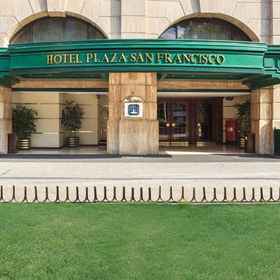
Hotels in Chile
Destinations to Discover
Popular Hotels in Chile
Discover what you like
Register to Use Your Coupon
Up to S$ 30 Flights
8% off Hotels
8% off Attractions
10% off Car Rental
12% off Airport Transfer
More about hotels Chile
There exist different explanations about the origins of the name "Chile." The most accepted one is that it is derived from the native Aymará word chill meaning "the land where the earth ends." Chile is considered to be one of the most homogeneous nations of Latin America in both ethnic and cultural terms. In contrast to many other Latin American countries, Chile has not experienced the emergence of strong regionalism or conflicting regional cultural identities. Since the late nineteenth century, both the northern and southern regions have been mainly populated by people coming from the central region, helping to strengthen the country's cultural homogeneity.
Notwithstanding the existence of a strong dominant national culture, some regional cultural traditions can be identified. In the northern provinces near Bolivia, Aymará Indians have been able to preserve many aspects of their Andean culture. In the southern region, the Mapuche Indians are a significant cultural group who actively contributed to the formation of Chilean culture. On Chiloé Island also in the south, a distinct chilote culture emerged over the centuries from a relatively harmonious blending of Indian and Spanish backgrounds; this culture is characterised by rich traditions of music, dance, and mythological tales. Some two thousand miles off the coast of Chile lies the remote Eastern Island, which is inhabited by twenty-eight hundred native islanders who still keep alive many of their Polynesian cultural traditions.
Since the late nineteenth century, Chilean culture has also been nurtured by the arrival of a large group of immigrants, mainly Germans, British, French, Italians, Croatians, Palestinians, and Jews. Today they fill leading positions in academic and cultural circles as well as within the country's political leadership. Nevertheless, many Chileans are often not even aware of their ethnic and cultural backgrounds, and they firmly embrace the dominant culture of mainstream society.
Chile is a broad and narrow strip situated in southwest South America, bounded on the north by Peru, on the east by Bolivia and Argentina, and on the west and south by the Pacific Ocean. Formidable natural barriers mark present-day Chile's boundaries, isolating the country from the rest of South America. To the north, the arid Atacama Desert separates it from Peru. The high Andes peaks constitute its natural frontier with Bolivia and Argentina. To the south, the cold waters of the Drake Sea announce the nearness of Antarctica. To the west, Chile looks at endless masses of the South Pacific water.
Between the vast Andes Mountains (to the east) and the lower Coastal mountains (to the west) is the great Central Valley, which extends from Salamanca, north of Santiago, for over 620 miles (1,000 kilometres) south to Puerto Montt. The country has a total area of 292,260 square miles (756,950 square kilometres).
Chile's geographical shape is quite peculiar. Chile has a longitude of 2,650 miles (4,265 kilometres) making of it one of the longest countries in the world. This is in dramatic contrast with the country's average width, which does not exceed 221 miles (356 kilometres). In some places, Chile is so narrow that the Andes peaks of its eastern border can be seen from the Pacific coastline.
Its length explains the great variety of climates and regions one can find from north to south. While the northern region is extremely dry (including the vast Atacama Desert and numerous places where no rain has ever been recorded), the central region is a fertile area with a mild climate. The southern region, by contrast, is chilly and rainy, having icy fjords and glaciers at the southernmost tip.
The capital city, Santiago, is located in the central region and constitutes the political, cultural, and economic centre of the country, and the homeland of the historically dominant Central Valley culture. Chile administratively divided into twelve regions (subdivided into thirty-one provinces) and a metropolitan region that includes the capital city.
How to Get There?
By Flight
Comodoro Arturo Merino Benítez International Airport or in Spanish known as Aeropuerto Internacional Comodoro Arturo Merino Benítez (IATA: SCL, ICAO: SCEL), also known as Santiago International Airport and Nuevo Pudahuel Airport, located in Pudahuel, 15 km north-west of downtown Santiago, is Chile's most significant aviation facility and the busiest international airport in the country. No airlines flying direct from Singapore to Chile. Qantas, KLM, LATAM Airlines Group, Emirates, Air France and British Airways flying to Chile and you may find a connecting flight from Singapore to the final destination.
What to do There?
Food Hunting
Food is a must try when you are in Chile. Chilean cuisine has both Indian and European influences. The national dish, porotos Granados, for instance, has ingredients characteristic of Indian cooking (corn, squash, and beans), with distinctly Spanish contributions (onion and garlic). As may be expected in a country with an extremely long coast, seafood has a prominent role in local culinary preferences. Traditional Chilean seafood includes locos (abalone), machas (razor clams), erizos (large sea urchins), and cochayuyo (seaweed). Another national delicacy is caldillo de congrio, a soup of conger eel, tomatoes, potatoes, onions, herbs, and spices.
Torres del Paine National Park
If you are wondering how to explore Chile, here are some suggestions for you. One of Chile's most spectacular natural areas and popular travel destinations in the Torres del Paine National Park. More than 100 kilometres north of the city of Puerto Natales in southern Patagonia, this beautiful area encompasses mountains, glaciers, and countless lakes and rivers. The most critical region of the park is the Cordillera del Paine, an area that marks the transition from the Patagonia steppe to the subpolar forests of the north. Perhaps the most notable of its many beautiful features are the three 2,850-meter-tall granite peaks of the Paine Massif, which dominate this already breathtaking scenery. Hiking is one of the park's most popular activities, with numerous well-marked trails, many offering overnight shelters (refugios) with the basics needed for longer treks that circle the mountains. Hot Tip: If you're planning on anything more than a day's hiking, professional guides are recommended and, in some areas, mandatory.
Valle de la Luna
Valle de la Luna, which means Moon Valley, lies 13 kilometres west of San Pedro de Atacama at the north end of the country near its border with Bolivia. This rugged, inhospitable looking landscape in the heart of the Atacama Desert attracts many visitors for its eerie resemblance to the surface of the moon, an effect caused by the erosion of its sand and stone features by wind and water over countless millennia. Despite its remoteness, this surprisingly beautiful landscape has sustained life for centuries, both human as well as that of numerous species of flora and fauna. Among its most interesting features are its dry lake beds (this is, after all, one of the driest places on the planet), which are white, due to deposited salt, and prone to producing fascinating natural saline outcrops. Other notable features of the Atacama Desert are the region's many caverns, some containing evidence of pictographs created by early man and where some of the world's oldest mummies, preserved by the area's aridity, were found (the most famous of these, the Chinchorro mummies, are now on display at the archaeological museum in San Miguel de Azapa).
Easter Island
First visited by Europeans in 1722, the magnificent yet remote Easter Island - so named by a Dutch Explorer who first set eyes on it on Easter Sunday - has been inhabited for thousands of years by Polynesians. Despite being more than 3,500 kilometres away from mainland Chile, this fascinating island with its remarkable stone sculptures remains the country's most recognisable attraction. All told, 887 of these statues, known as Moai, created by the island's early Rapa Nui population, have been identified, most of them now protected by Rapa Nui National Park (the island itself has been declared a UNESCO World Heritage Site). The most impressive collection is at Ahu Tongariki where 15 of them have been re-erected on the island's largest Moai platform, or "ahu." Also of interest are the many "hare paenga" ruins near ahu sites consisting of stones that once formed the foundation of boat-shaped houses. Other highlights include the Father Sebastian Englert Anthropological Museum in Hanga Roa, the island's central community, notable for its exhibits relating to the history of the Polynesian islanders and their traditions. Hot Tip: Visiting Easter Island is best done as part of a Chilean vacation, with regular flights available from Santiago or Tahiti (flight times are approximately five hours, so expect to stay at least a couple of days).
Where to Stay?
The Ritz Carlton
The Ritz Carlton, Santiago is strategically located in the capital's most prestigious and refined neighbourhood, El Golf. The 205-room hotel is just 30 minutes from Santiago International Airport and within walking distance to exclusive boutiques and restaurants. The hotel offers a Mediterranean Restaurant And Wine Bar Featuring Chile Best Products. The Health Club Features Spectacular Views Of The Andes Mountains And City Center. Rooms Feature Rich Combination Of Earth Tones And Gold In A Classic Decor Style. Besides good business, the capital city promises entertainment, pleasure and excitement for fans of outdoor activities such as skiing, surfing or trekking among the Andes Mountains.
Grand Hyatt Santiago
Acknowledged as one of Santiago's finest hotels, Grand Hyatt Santiago, formerly the Hyatt Regency Santiago, is located in an exclusive residential neighbourhood, 20 minutes away from Santiago city centre and within easy access of Santiago's international and domestic airports. Grand Hyatt Santiago is just one hour's drive from the most important ski resorts or the coastline. Widely regarded as one of the most exclusive hotels in Chile and Latin America, Grand Hyatt Santiago has received many awards from prestigious publications such as Conde Nast Traveler, Latin Finance, Latin Trade and Travel + Leisure. Grand Hyatt Santiago's accommodations comprise 310 guest rooms and suites all of which offer stunning views of Santiago and the Andes Mountains.
Facts about hotel in Chile
Total Accommodation | 20 Properties |
Popular Region | Santiago Province, Antofagasta |
Popular Hotel | Mandarin Oriental, Santiago, Pullman Santiago Vitacura |
Frequently asked questions

Guest reviews hotel in Chile
Why book Accommodation in Traveloka?



We’ve got more than just hotels
What interests you?
































 Facebook
Facebook Instagram
Instagram TikTok
TikTok Youtube
Youtube Telegram
Telegram